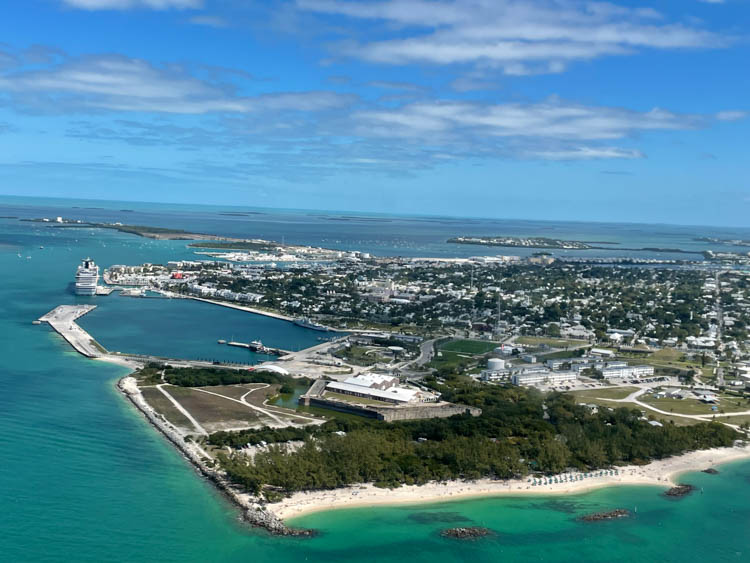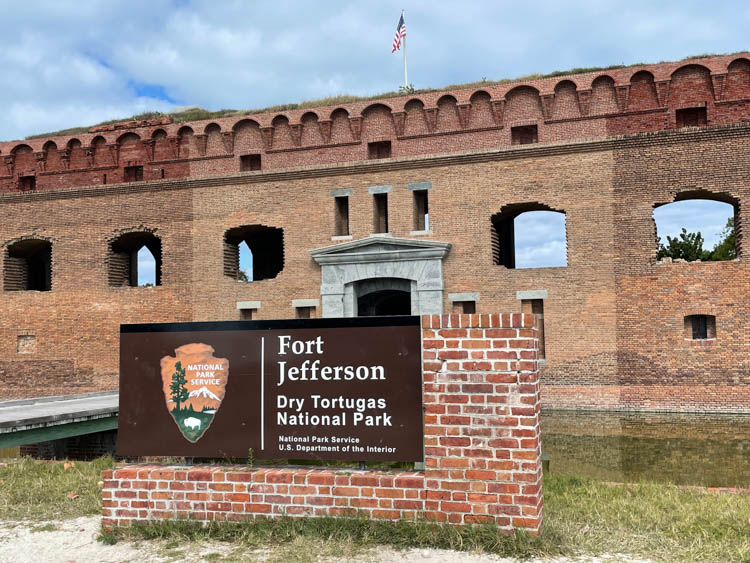
Go World Travel is reader-supported and may earn a commission from purchases made through links in this piece.
The seaplane kissed the water as we landed at Dry Tortugas National Park, one of our country’s most inaccessible national parks.
It had been a smooth 35-minute flight on Key West Seaplane Charters departing from Key West. Plus, the sights enroute were incredible.

The Seaplane Adventure Day Trip to Dry Tortugas
Opting for the seaplane for a Dry Tortugas day trip was a no-brainer for me. The only other means of getting there is by ferry, which typically takes over two hours.
I wanted to get to the island as quickly as possible and have the place to roam crowd-free. I also knew that the seaplane experience offered a unique bird’s eye perspective of the landscape.
After leaving Key West, we flew over an area known as the “Flats.” This shallow body of water, which spans almost twenty miles, is great for spotting marine life. We saw sharks and sting rays from our perch in the sky.
Of course, they looked like dark blobs from above. I probably wouldn’t have been able to identify them had it not been for our pilot, Marcus. But it was exciting, nevertheless.

There were also numerous uninhabited mangrove islands along the way, Ballast Key being the exception. Once a private island owned by Key West, Florida icon David Wolkowsky, it is now under the government arm of the U.S. Fish and Wildlife Service.
There’s a main residence, guest house and workshop, but only the former is visible from a seaplane or via the ferry.

Sea Turtles and Shipwrecks Ahead
The flight path then took us over the Marquesas Islands. It is a coral atoll which we learned via the audio narration is volcanic in origin. Beyond these islands are the “Quicksands,” where we spied huge sea turtles swimming in this underwater desert.
The sea-bed is actually made up of ginormous sand dunes that move continually due to the strong tidal currents. This is also an active treasure site.
It is known by treasure hunters for its regular finds from the 1622 ill-fated voyage of a pair of Spanish galleons, Atocha and Santa Margarita.
The ships were heading to Spain full of plundered New World treasures. Spain was anxiously awaiting the arrival of the fleet, as the precious cargo was necessary to pay off its debts and loans and ease financial pressures.
However, after the ships left Cuba, they were overtaken by a hurricane and within days, the Atocha and Santa Margarita went down.
More than five hundred people drowned, along with over half a billion dollars’ worth of gold and silver. It was a serious setback for Spain, whose global dominance was supported by the wealth of the Indies.

Flash forward to 1980 when noted treasure salver Mel Fisher and his team discovered a portion of the Margarita and recovered about $25 million in treasures and artifacts.
Five years later and three miles away, they found a section of the Atocha shipwreck – a $400 million find. Today, millions in lost riches from these shipwrecks still remain buried beneath the sand and mud.
Other shipwrecks from modern times have occurred in this location, and we were able to see two of them through the windows of the seaplane. The first was the remains of a WWII Destroyer Escort, the Patricia, which was intentionally sunk by the U.S. Navy in bombing practice.
Another, the Arbutus, sank due to hull deterioration. It was a work vessel used by Mel Fisher’s divers. Thankfully, there was no loss of life.

Historic Fort Jefferson
As we came into view of Garden Key, Fort Jefferson made its appearance. Garden Key is one of seven islands that comprise Dry Tortugas National Park. First discovered by Ponce De Leon in 1513, these islands were named Las Tortugas, “The Turtles,” due to the abundance of sea turtles. The word “dry” was subsequently added to alert mariners of the dearth of fresh water.
Fort Jefferson, the National Park’s most significant site, dates back to 1846 when construction of the Fort began. The U.S. wanted to control navigation to the Gulf of Mexico, while protecting trade headed to the Mississippi. Thus, the reason for fortification. Construction on the fort continued for over thirty years, but it was never finished.
In its uncompleted state, the fort served as a military prison for captured deserters during the Civil War. It also held the four men convicted of complicity in President Lincoln’s assassination, the most famous being Dr. Samuel Mudd, the man who treated John Wilkes Booth after he shot Lincoln.
Towards the end of the war, the population on this remote garrison neared 2,000. The conditions were poor, as fresh water and food were always in short supply.
Soldiers had to wear hot, heavy uniforms and their morale was low. Diseases were prevalent, especially scurvy. And the moat that surrounded the place ended up acting as an open sewer.
The Army abandoned Fort Jefferson in 1874. Years later, it became a wildlife refuge to protect nesting birds from egg collectors.
Then, in 1935, it was designated a National Monument. It wasn’t until 1992, however, that Dry Tortugas was given National Park status.

Explore the Fort
Visitors can do a self-guided tour of the fort, which covers eleven acres of the island’s total sixteen acres. It has undergone few changes since its original construction and as you walk around it, you can almost imagine what it was like to be at this isolated outpost 150 years ago.
This massive bastion is comprised of over sixteen million bricks. As such, it is the largest brick masonry structure in the Americas. In several places, it’s crumbling down and in ruins. but you can also see some of the structural renovation and work that is being done to preserve the site.
There are several levels of the fort, reached via spiral staircases. Informational panels are posted in various spots and are helpful for identifying the different areas of the building, as well as for describing life for those stationed and imprisoned at the fort. They also provide details regarding the ammunitions and military weapons housed inside.

Make your way up to the top level for the most spectacular panoramas of the island. You can walk around four of the six sides, with vistas in almost every direction. And don’t forget to do the pathway around the moat, which offers some of the best views of the fort.
Dry Tortugas is known for its living coral reef, which is accessible to snorkelers right off the main swim beach. The shallow, clear and warm water are prime conditions for coral reefs to develop.
The reefs teem with marine life – everything from sea anemones and lobsters to sponges and a plethora of colorful fish. At the top of the food chain are sharks and barracudas.
The islands are also home to endangered green sea turtles and threatened loggerhead turtles, who nest on the beaches. A female may lay up to a hundred eggs. She covers them and then retreats to the sea, while the hatchlings will instinctively crawl to the water. Unfortunately, many don’t make it due to natural predators.

Birds Abound on the Island
If you’re a birder, a Dry Tortugas day trip is heaven. This is because many species fly over or rest on the island, as they are on the main route between North and South America.
In the winter, Sooty Terns are the stars. Upwards of 100,000 of these birds gather here for nesting season. Sharing the space with them are Brown Noddies. The area is closed to visitors during this time, but with binoculars, you can get a look at the rookery.
Other birds commonly seen flying around are frigates, pelicans and cormorants. The frigates, in particular, elicit awe for their seven-foot wingspans. When they soar, they are a thing of beauty.
There’s no food or drink available on the island, so take what you need for your day trip to Dry Tortugas. Thankfully, there are toilets. If you want to spend the night, you’ll need to reserve one of the eleven campsites available.
On the return flight back to Key West, you might think the trip would be a rather ho-hum experience, as the route is basically the same. Au contraire. The scenery is equally as mesmerizing and the colors of the water, are beyond description, but now you know exactly what to look for. With your eyes primed, you notice more details and savor the sights. All too soon you’ll be on terra firma.
Book This Trip
Start planning your island vacation to the Dry Tortugas National Park today. Get prepared with insider knowledge on the best island sights, hotel and VRBO accommodations, local restaurant reviews and more through TripAdvisor and Travelocity.
Be sure to bring a travel bag that is stylish and reliable with an AWAY Travel Bag. Check out their selection of best-selling luggage, travel accessories and small travel bags here.
For the ultimate flight deals, car rental options and vacation packages, check out CheapOair.
- Discover Claremont, California Along Historic Route 66 - December 6, 2024
- Three Sites to Soothe the Soul in Kyoto, Japan - December 5, 2024
- 13 Essential Tips For Women Traveling in Morocco - December 4, 2024

